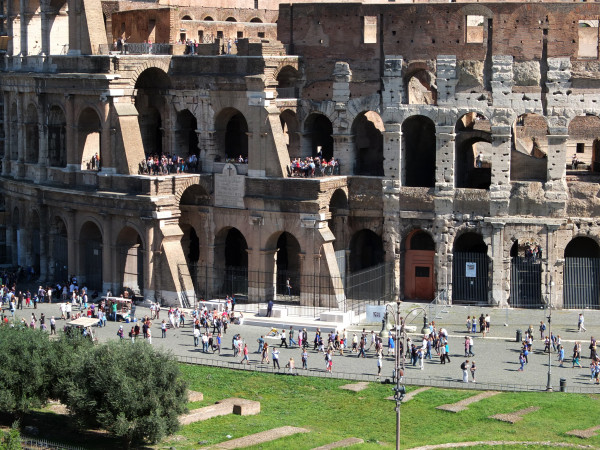 We rent an apartment that (literally) overlooks the Coliseum, the ancient Flavian Amphitheater that first opened in 80 AD.
We rent an apartment that (literally) overlooks the Coliseum, the ancient Flavian Amphitheater that first opened in 80 AD.
We sit on the terrace every evening and watch ‘closing time’ in the Piazza del Colosseo. A voice comes over the public address system and informs the tourists, the great Amphitheatre is about to close. The last tours of the day exit the great Arena arches and head off to their tour buses. Street vendors attack them with last chance opportunities to buy selfie sticks or splatty balls. Costumed Gladiators try to get into the final photo memories of the day. Crowds disperse in every direction. Depending on the time of the year, the announcement can come anytime between 4:30pm and 7:00pm. I can’t think of a better way to end the day.
The Coliseum, Colosseum or Colosseo is, and has been, the ancient centerpiece of Rome for over 1,935 years. It was the greatest entertainment building in the known world, seating over 50,000 people.
Over 4 million people each year still visit this great Arena, and even though less than half the structure is original, it is still the largest amphitheater in the world and the greatest piece of western antiquity still standing.
The name alone has become synonymous with arenas and entertainment complexes all over the world; The Oakland Coliseum, The London Coliseum, The Los Angeles Coliseum and the Toronto Coliseum are just a few. I’m pretty sure a Coliseum of some sort is very close to your neighborhood.
It was first known as the Flavian Amphitheatre (Amphitheatrum Flavium) after the Flavian family who commissioned the project. Emperors Vespasian, Titus and Domitian were all Flavians. The word Amphitheater comes from the Greek ‘amphi’ (both sides) and theatron (semi-circle theater). The concept was two theaters facing each other.
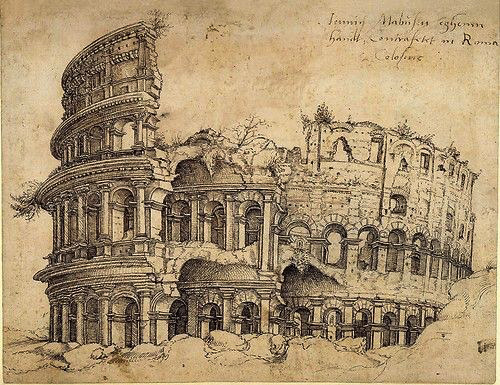
In it’s first few hundred years, The Flavian Amphitheatre was destroyed a few times by lighting and fire. Reparations and alterations were made until 523. After that it just got too expensive to maintain.
It’s been looted and pillaged since the 6th century. Over 300 tons of iron clamps were stolen. The clamps once held the travertine blocks together, yet, even without the support clamps, the structure has survived.
It was a Medieval Feudal Fortress in the 13th and 14th centuries.
The Earthquakes of 1349, 1720 and 1806 knocked down the southern outer ring wall. The brick abutment walls currently holding the outer walls in check were built in the mid 19th century. It’s actually easy to see the old from the restored.
It was mined for stone used to build St Peter’s and renovate St John Lateran as well as other building projects from the 14th – 17th centuries.
It was a Glue Factory, a manure dump for the manufacturing of saltpeter (the main ingredient of gunpowder), a shelter for the homeless and a Nazi munitions dump.
It has entertained the masses with animal hunts, battle re-enactments, Gladiator combat, public executions, bullfights, Passion Play commemorations, pep rallies for Fascists and a Paul McCartney Concert in 2003. In his long career, Sir Paul has played in at least 10 Coliseums throughout the world.
A lot of history can happen in 1,935 years. The only problem with history is that it is always revised. In the words attributed to Napoleon, “History is the lie commonly agreed upon”.
We know a lot about ancient Rome because the Romans were dedicated writers of histories, even though many of these authors seem to write conflicting details of what happened. History always seems to be politically motivated and those who control the pen are always able to change the course of past history.
It’s easy to understand how fact and fiction can be confused.
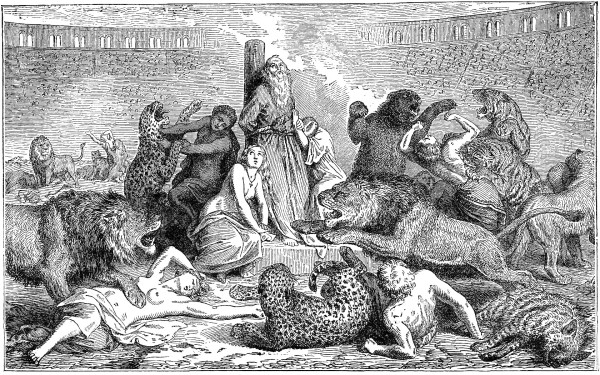 It’s the Christians vs. the Lions
It’s the Christians vs. the Lions
‘Damnatio ad bestias (death by damnation of the beasts) was indeed a form of capital punishment practiced in the Flavian Amphitheater (the Coliseum) of Rome.
Animal hunts were a big part of the public games. Exotic creatures were brought back from every corner of the vast Empire; lions, tigers, bears, panthers, rhinos, elephants, giraffes, hippos, crocodiles and exotic birds.
For the inaugural games of the Amphitheater in 80AD, it was written that 9,000 beasts were slaughtered, although that’s probably a huge overstatement. The accepted number these days is 5,000. The inaugural games last 100 days which, on average, would be about 50 animals per day.
Although most of the animals were slaughtered in the hunt, some of them became the executioners of condemned prisoners. Some of these condemned prisoners were undoubtedly Christian.
They were tied to poles, torn apart and devoured by lions, tigers and bears. However, not all prisoners suffered damnatio ad bestias. Some of them were crucified (a common form of execution) or, they were imprisoned.
Romans were a no nonsense kind of people when it came to punishing and subjugating their enemies. However, Romans were also known to be very tolerant and respectful of other religions, admiring some of them so much, they assimilated many of the foreign gods into the Roman pantheon. They adopted gods from the Etruscan, Sabine, Greek, Phoenician, Persian and eventually the concept of monotheism (also from the east).
The only thing Rome demanded of these foreign religions was respect of the Roman gods. It was no bother for Egyptians or Jews or Persians living in the Roman Empire to visit a Roman temple on a feast day and offer a bouquet of flowers or pay one’s respects.
This concept seem to work well for everyone except the Christians who felt it was their mortal cause to convert everyone on the earth to their way of thinking.
At first they did it in small groups but when they took it to the streets and began a public rebellion against the Roman way of life, it was considered treasonous.
The Christians knew what they were doing. They knew they were breaking the Roman laws but they didn’t care. They knew many of them would die but they felt in their deaths they would be able to inspire others to convert. It was the basic form of Religious fundamentalism.
Christians were found guilty, and occasionally condemned to death for inciting mobs, unlawful assembly, instigating and escalating confrontation against the Roman people, unlawful magic, illegally influencing Senators and disrespecting Roman Gods.
They were persecuted for acts of treason for over 260 years until the Emperor Constantine made Christianity the approved religion of the Empire in the year 325.
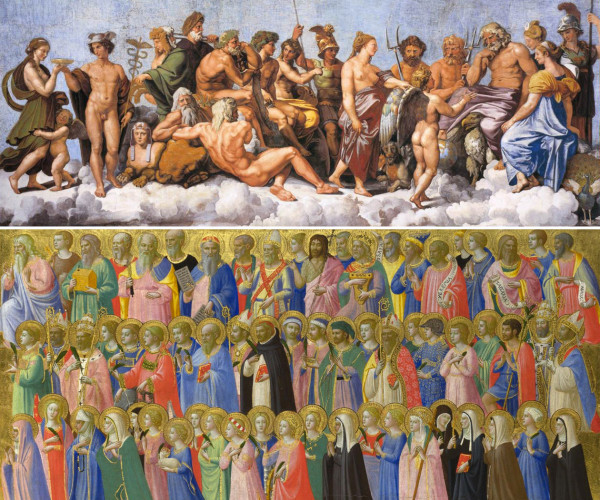 Romans were blessed by hundreds of gods; household gods, gods of love, fertility, war, courage, music, harvest, etc.
Romans were blessed by hundreds of gods; household gods, gods of love, fertility, war, courage, music, harvest, etc.
If Christian Monotheism was going to replace Roman Polytheism, the Christians needed to create a similar culture of deities. The concept of Saints worked perfectly.
Today Christians might have more Saints than Romans had gods.
The Coliseum gave the Church the opportunity of hundreds of martyred Saints, maybe even thousands.
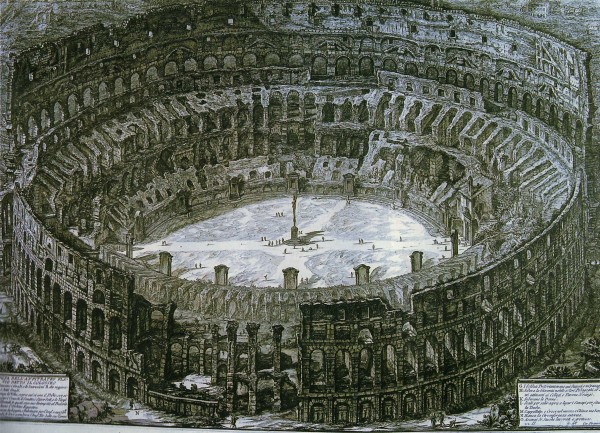
In the 16th century, Pope Pius V gave away relics of the sand of the Coliseum to pilgrims visiting Rome, telling them the sand was impregnated with the blood of the Christian Martyrs.
In the 18th century, Stations of the Cross were erected inside the Coliseum when it was sanctified as a Church in Memory of the Martyrs who died in the Arena. The crosses remained till 1874.
Although the sanctification of the Coliseum as a Church might have been a stretch of the imagination, it did stop the pillage and dismantle of the ancient monument. Basically, the theory of Christian Martyrs saved the Coliseum from complete destruction.
It is hard to find evidence of Christians killed in the Coliseum. Records of executions have never been found.
Tertullian, the 3rd century Christian writer from the Roman Provinces of North Africa claims Romans sent Christians to the lions but no one even knows if Tertullian ever went to Rome.
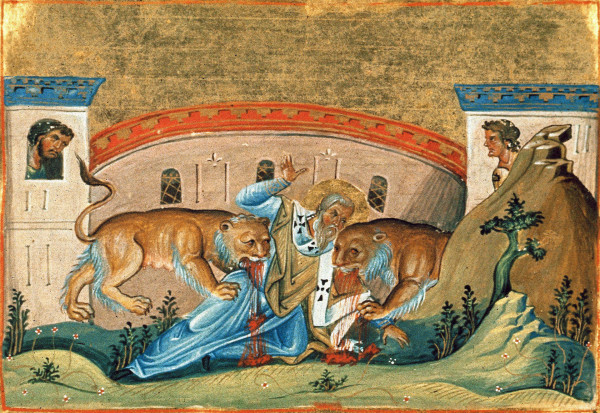
The only possibility for a tie in to a Christian Martyr story is with the death of Saint Ignatius, the2nd Century Bishop of Antioch (Syria) sentenced to die in the Coliseum.
On his way to Rome, Ignatius wrote a series of letters about his fear of being killed by wild animals and his strength in his beliefs.
Although Saint Ignatius is the only plausible candidate for Coliseum martyrdom, Christianity still tries to get another one in there.
Around 394, Emperor Theodosius banned paganism in the Roman Empire and began prosecuting anyone practicing the old religions.
This decree of Theodosius was finally completed in Rome on January 1st, 404, when his son, then 20 years old Emperor Honorius, destroyed the Temple of the Vestal Virgins, banned pagan Holidays and ended the Gladiatorial games.
By the way, Honorius, considered one of the worst Emperors in the history of the Empire, was the Emperor of Record when Rome fell in 410.
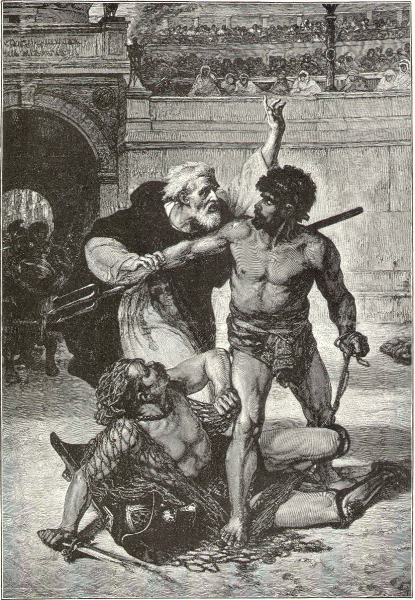
Christianity seized this opportunity to create the story of Saint Telemachus, a (possibly) Syrian monk, who during a gladiatorial combat on the 1st of January 404, jumped into the arena and tried to stop the fight. He was killed by one of the gladiators. The crowd was so moved by his death, they changed their view on blood sport and all converted to Christianity.
No one knows if the story is really true or if in fact it even took place in the Coliseum. The story of Telemachus has been repeated many times over the years and, of course, the details always change.
Conclusion:
In 394, when Emperor Theodosius made it illegal to worship the pagan gods, the political landscape changed and the Christians became the Lions.
Eventually, it was the Romans who were persecuted by the Christians. Thousands of Polytheistic believers were killed. Priests were murdered and temples were destroyed. Hypatia, the Egyptian/Greek mathematician and philosopher was one of the more famous of the Christian mob killings of the 5th century.
In 782, Charlemagne killed 4500 Saxons who would not convert to Christianity.
Jewish Synagogues were destroyed and Jews were terrorized, killed and enslaved. Muslims were slaughtered in the Crusades and Religious Wars.
Eventually Christians began devouring their own over different interpretations of the religion. There were wars between Eastern Orthodox and Western Latin Churches, Inquisitions and witch hunts, the 13th century massacre of over 20,000 Christian Cathars and the wars against the Protestants that lasted for hundreds of years.
Poor Christians unable to pay the heavy taxes to support the Church were killed. Indigenous people were enslaved and killed, their wealth stolen and given to the Christian powers of the West.
Although the moral conscience of the Church has recently adopted a policy of love, tolerance and understanding for all people, it hasn’t stopped hate crimes, racial prejudice, religious intolerance and whacko Christian Fundamentalists.
If Christians did die in the Coliseum, after all these years, it’s difficult to understand what they actually died for.
Nero did not build the Coliseum
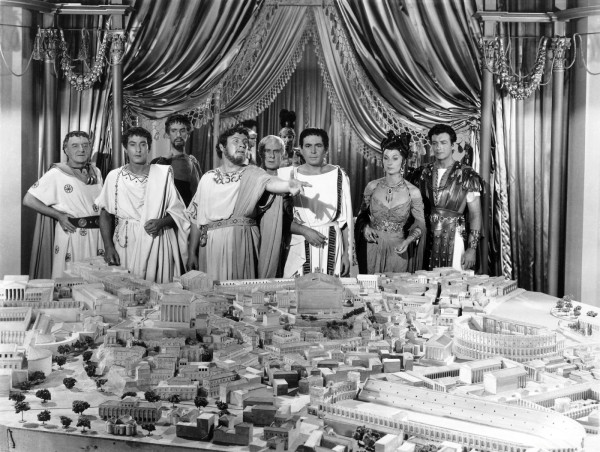
In the 1951 Hollywood film ‘Quo Vadis’, the Emperor Nero (excellently interpreted by Peter Ustinov) blames the Christians for the great fire of Rome in 64AD and condemns them all to dies in the Coliseum. Here’s the movie clip.
In the photo above, Nero is showing how he’ll build his new city with a model of Rome, similar to the famous ‘Il Plastico’, a scale model of Rome started in 1935.
It’s great Hollywood style propaganda, right down to the Romans laughing as the Christians are devoured by lions, who are about as ferocious as household tabby cats.
The Amphitheater began construction in 71 AD. It wasn’t completed until 80 AD. Nero died in 68 AD. That’s right, Nero died before the Coliseum was built.
In one of the most ironic of historical twists, the Flavian Amphitheater was actually built to remove the memory of the Emperor Nero from the minds of the Roman citizens.
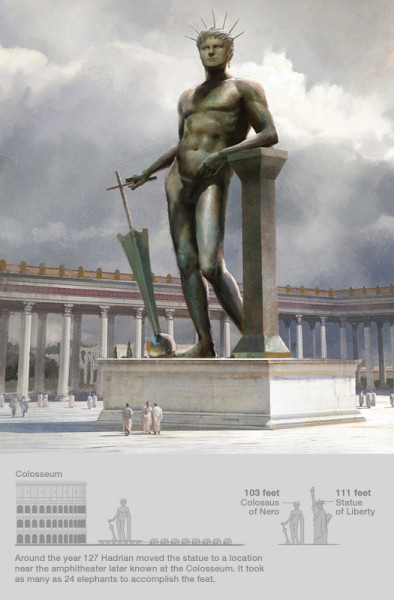
Nero had greatly depleted the treasuries to build his Golden Pleasure Palace.
When Titus Flavius Vespasian became Emperor, the treasure from his victory in the Judean War of 66-71 AD paid for his new Temple of Peace and the new Flavian Amphitheater erected over the artificial lake built for Nero’s Palace.
Among the amazing treasures of Nero’s extravagance was a +100’ tall bronze statue made in the likeness of the Emperor Nero that would greet the guests as they entered his Palace.
After Nero’s death, the statue head was replaced with one to resemble the god Sol Invictus with a headdress of sunrays extending over 23’.
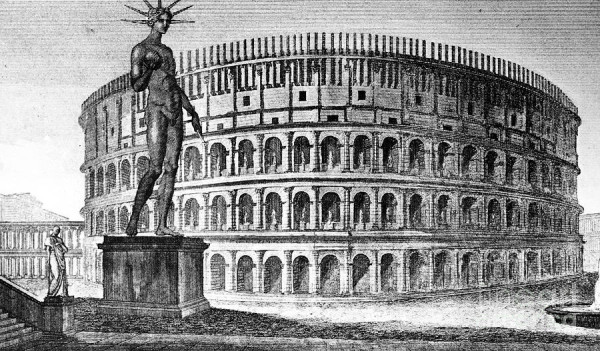 Around 128 AD, the Emperor Hadrian moved the Sol Invictus statue to a platform outside the Flavian amphitheater.
Around 128 AD, the Emperor Hadrian moved the Sol Invictus statue to a platform outside the Flavian amphitheater.
The platform is still there. There is plaque commemorating the statue.
During the Middle Ages the statue became known as the Colossus, at least until it was dismantled and sold off for scrap. Even with the colossal statue gone, the amphitheater was tagged with the name for all eternity.
Conclusion:
In the modern world, Nero is still much more popular than Vespatian or any of the Flavian Emperors that followed him.
In Rome, Vespasian is more famous as the Emperor who first brought pay toilets to the Empire. Pay toilets are still called vespasiano.
The Coliseum was built by Jewish Slaves
As a conquering nation, Rome adhered to the political norms of the day. The defeated paid tribute to the victor in the form of wealth and slaves or the defeated was wiped off the face of the earth. Much of Rome or any other great ancient Empire was built by slave labor.
Yes, slaves from the Judean Revolt of 66-71AD were brought back to Rome and used to build the Coliseum.
Judea was conquered by the Babylonian Empire in the 6th century BC. After a brief independence, Judea fell to Alexander the Great in the 4th century BC and then to the Seleucid Empire until 160 BC when the Maccabean revolt gave Judea back to the Jews.
Unfortunately, in order to win the war against the Seleucids, Judas Maccabee made an alliance with Rome. It proved to be a better deal for Rome than Judea.
Around 67 BC, Gnaeus Pompey Magnus (Pompey the Great) came to Judea to squash a civil war and decided the best solution (for the glory of Pompey) was to make Judea a Roman territory.
Judea became a jewel in the crown of the Roman Empire. Rome installed puppet Kings and governments and soaked the people with high taxes and tributes. Around 64AD, a Judean rebel group known as the Zealots kicked up some dust and by 66AD, the country was in a full-out war with Rome.
By 71AD, the revolt was crushed. The Roman General, Vespasian marched back to Rome and took the title of Emperor. He left his son, Titus in Judea to finish the job and bring back the loot and slaves.
Some 70,000 Judean slaves were brought back to Rome to work on the new building projects. 20,000 of them worked on the construction of the Flavian Amphitheater in Rome. Another 50,000 mined the travertine stone from the mines in Tivoli about 20km away. It has been estimated that over 100,000 cubic meters of travertine were used just for the outer ring wall.
The descendants of the Jewish slaves were given Roman citizenship in 212 during the reign of the Emperor Caracalla.
Many of Rome’s Jewish families trace their lineage back to the Judean slaves.
Conclusion:
The relief (shown above) on the inside panel of the Arch of Titus in the Ancient Roman Forum details Titus removing the Golden Menorah from the Temple of Solomon and leading a group of conquered Judeans in a triumphal parade.
In the 16th century, Pope Paul IV created the Jewish Ghetto in Rome, a walled in community built to keep the Jews separated from the rest of Rome. According to the Papal Bull, once a year, all Jewish citizens of Rome had to stand under the Arch of Titus and swear allegiance to the Pope. It was a double insult.
Even after the walls of the Ghetto were torn down, Roman Jews refused to walk under the Arch of Titus.
According to some Jewish scholars, the Talmud still forbids Jews to walk under the Arch of Titus.
Hail Caesar. We who about to die salute you.
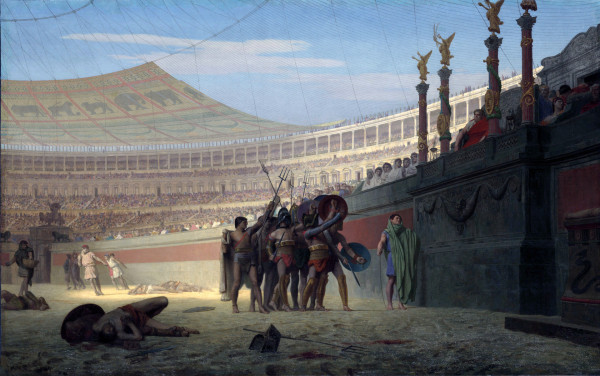
Ave Caesar. Morituri te salutant (Hail Caesar, those about to die salute you) is one of the most famous expressions of Gladiatorial combat.
However, the legend of the expression originates from the 1859 painting by French artist Jean-Léon Gérôme entitled Ave Caesar, Morituri te salutant.
The painter/sculptor, Jean-Léon Gérôme was passionate about classical history and apparently did extensive research in Pompeii for background to some of his most famous paintings. What he didn’t know, he just made up. These days we call it ‘Artistic License’.
The expression however, does stem from Suetonious, the 2nd century gossip/historian and author of the 12 Caesars. The reference from Suetonius, however, comes from an event that took place in 52 AD, 28 years before the Coliseum ever had a Gladiatorial fight.
Suetonius recounts an event during the time of Emperor Claudius. A mock naval battle was staged on Lake Fucinus, a large lake in central Italy that was drained in 1875. The prisoner/captives scheduled to die in the defeated naval ship shouted Ave Caesar. Morituri te salutant to the Emperor Claudius. According to Suetonius, Claudius replied ‘Aut non’ (or not).
Supposedly the criminals heard the Emperor (from a long distance away) and thought he was pardoning them and they all left their posts in the mock battle. Claudius had to abruptly get up and convince the criminals back into their positions or die a worse death.
The phrase was never uttered again in Roman historical records.
Conclusion:
The only time it was mentioned in the Coliseum was in the 2000 Ridley Scott film ‘Gladiator’.
Ridley Scott was a big fan of the Jean-Léon Gérôme paintings.
Thumbs Up, Thumbs Down
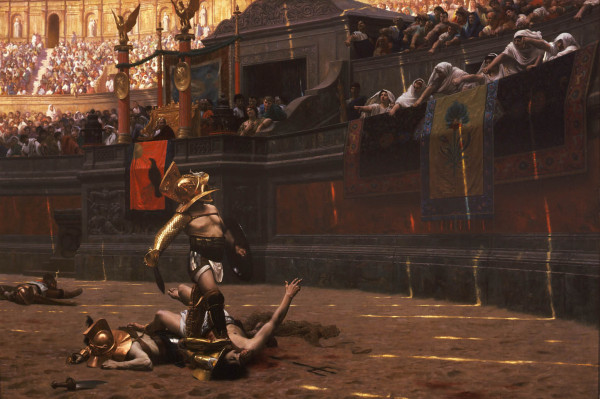
Once again, the legend comes from the French artist, Jean-Léon Gérôme. This time from his 1872 painting entitled ‘Pollice verso’.
The fate of a fallen gladiator was definitely influenced by the crowd who used the gesture known as the ‘pollice verso’ (turned thumb). Jean-Léon Gérôme found the gesture name from the gladiator games from Pompeii.
However, ‘pollice verso’ (as Gérôme interpreted) was not a turn of the thumb up or down.
The turn of the thumb to gesture death was actually an upturned thumb, moving in a slicing manner under one’s chin, representing a blade slicing the throat of the condemned fighter.
If the crowd wanted to spare the life of the fighter they would conceal the thumb inside a fist, a gesture known as ‘pollice compresso’ or compressed thumb.
Conclusion:
In many parts of the world these days, thumbs up means everything’s good or AOK. It’s not certain, but most likely the gesture originated from Jean-Léon Gérôme’s pollice verso painting.
The origin of the outstretched thumb used for hitching is unknown except that it came in with the automobile in the 1920’s. Thumbing even became an accepted verb form. In the movie “It happened one night”, Clark Gable gives a thumbing lesson to Claudette Colbert.
However, there are parts of the world where ‘thumb up’ gesture actually means (vulgar) ‘up yours’.
The Gladiator Emperors
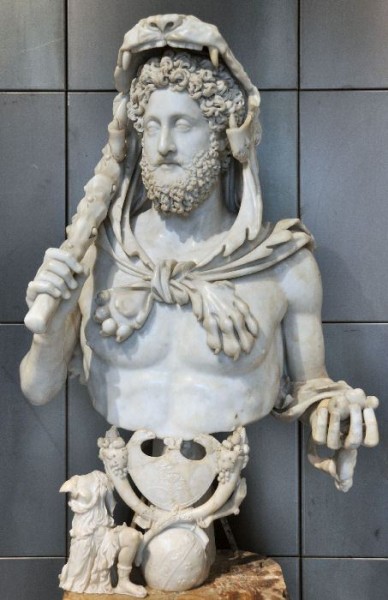
In Ridley Scott’s 2000 film ‘Gladiator’, the unhinged Emperor Commodus was obsessed with fighting in the arena.
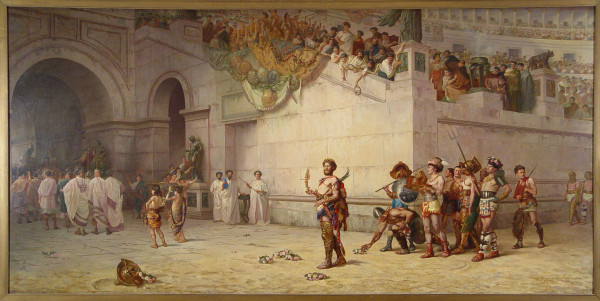
The painting by Edwin Blashfield (below) depicts him dressed as Hercules, holding the a small statue of the Winged Goddess of Victory.
He is given a palm leaf (a trophy of victory) as he exits through the Porta Triumphalis of the Coliseum.
Historically, this is correct.
He actually styled himself as Hercules Reborn.
Commodus did fight a few man-to-man combats although they were not to the death. They were armed with wooden swords.
Most of his contests of strength were in animal hunts. He would be propped up on a platform and shoot arrows into a crowd of wild beasts, literally shooting fish in a barrel.
According to the 2nd century historian, Cassius Dio, on one occasion, Commodus opened up the games by killing 100 bears with spears thrown from specially designed walkways around the Amphitheater. Dio implies the slaughter was more of a demonstration of skill than a demonstration of courage.
Emperors Titus, Hadrian and Caracalla were also known to show off in the animal kills but there was never any threat of danger to the Emperor.
In one great story from Pliny the Elder, a whale got caught in the harbor at Ostia. Emperor Claudius ordered nets to trap the whale while he and the Praetorian Guard threw lances at it until they killed it.
Conclusion:
Emperor animal hunts were more like executions.
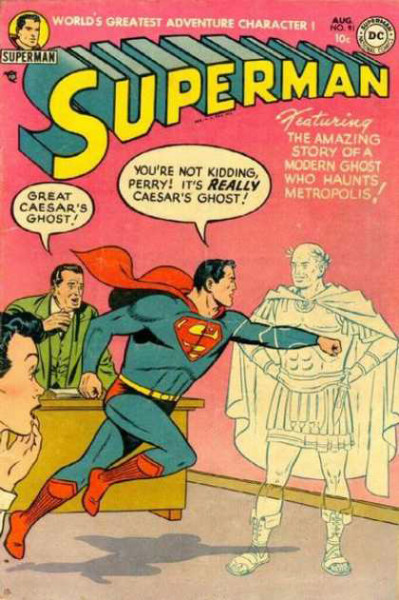 Is the Coliseum haunted?
Is the Coliseum haunted?
Although Julius Caesar was killed in 44 BC and construction on the Coliseum didn’t even begin until 70AD (114 years later) his ghost has nonetheless been sighted haunting the Coliseum.
Ghosts have no boundaries. There are legends that a ghostly spirit will always remain in the location where it died but why? If spirits can cross from one dimension to another, why can’t they cross a few blocks.
If the ghost of Julius Caesar is haunting Rome, why not at the Coliseum? Why not haunt the Vatican for that matter, the MAXXI, Rome’s modern art museum of the 21st century.
There are reports of paranormal hauntings all the time in the Coliseum. People have reported cold spots or ghostly whispers or phantom hands pushing them when no one was near.
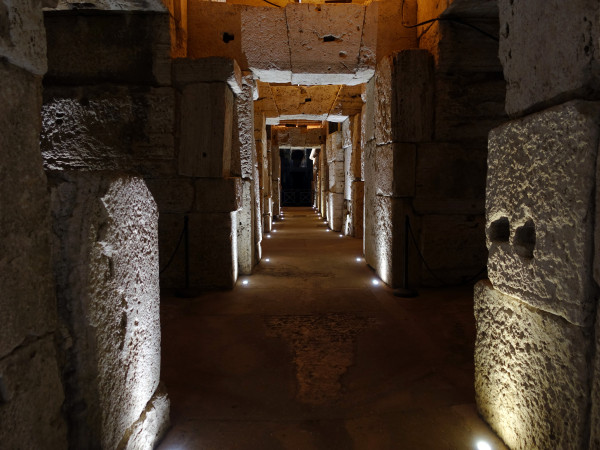 People working in the Coliseum have said they heard noises and screams both human and animal. Some have even seen figures in the seating area.
People working in the Coliseum have said they heard noises and screams both human and animal. Some have even seen figures in the seating area.
In the right atmosphere and setting, you could be convinced of many paranormal activities.
Conclusion:
It is always a few degrees colder inside the Coliseum. Some say it’s all the stone. Other will tell you it’s all the ghosts.
Were Naval battles (Naumachiae) staged in the Coliseum?
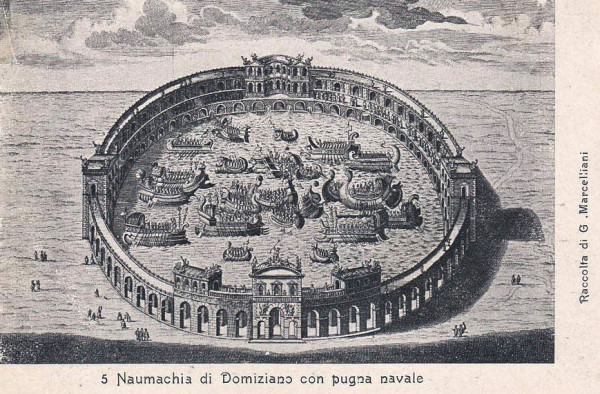
According to the Roman historian, Cassius Dio, the Emperor Titus filled the Amphitheater with water and created an artificial lake and staged naval battles. Dio also mentions Titus filled the lake with animals he taught to swim.
The poet, Martial also claimed to have witness naval battles in the Flavian Amphitheater.
The idea of flooding the Arena for naval battles (Naumachiae) has been debated for centuries.
Nero’s artificial lake was dug out and filled in by water from a nearby river. The river (known as the San Gregorio River) is now buried under the area surrounding the Coliseum.
After Vespasian had Nero’s lake drained, he filled it in with dirt, concrete and brick for a strong foundation. Still, the low valley location flooded during the rainy seasons.
We know that water drains were installed in the original design, but until recently, there were no reliable evidence for a way to efficiently and quickly flood the great arena for a naval battle.
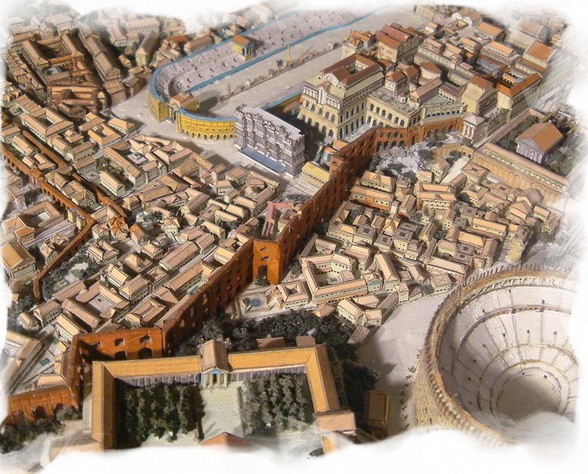 Recently, Dr. Martin Crapper, an expert in Hydraulic Engineering at Edinburgh University came up with a plausible explanation.
Recently, Dr. Martin Crapper, an expert in Hydraulic Engineering at Edinburgh University came up with a plausible explanation.
According to Dr. Crapper the water could have come from the Aqua Claudia that flowed down the Caelian Hill less than 500 yds. from the Amphitheater.
In 79 AD, Emperor Titus did commission repairs to the aqueduct that could have included a spur to fill the Flavian Amphitheater with water.
Aqua Claudia brought over 50.5 million gallons a day into Rome, over 2 million gallons per hour.
Crapper estimated that the spur from the Aqua could easily fill the arena with over 4 million gallons of water in less than 7 hours. That would be enough water to create a depth of over 5 feet inside the amphitheater.
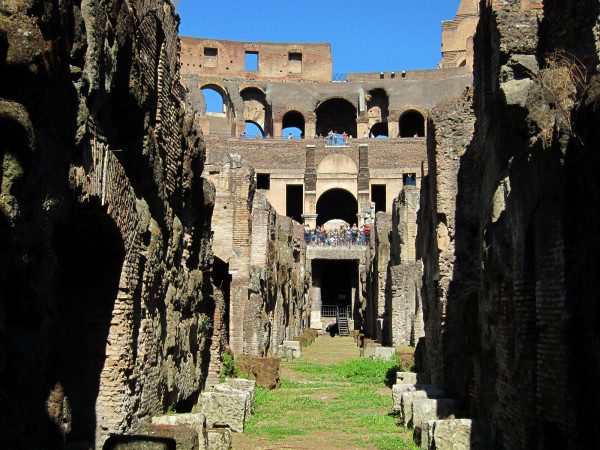
Further investigation has proven that the lower levels of the Coliseum, known as the Hypogeum, were partially constructed with a waterproof type of pozzolanic cement. There are also artifacts to reinforce the theory that the system of water coming into the hypogeum had sluice gates to regulate the level of water.
The arena floor could have been constructed with interlinking beams that could be removed and re-installed in a few hours.
The inauguration games in 80 AD lasted 100 days. It is conceivable that one of the first days was given over to a Naval Battle.
Suetonius also writes he witnessed a Naval battle during the reign of Domitian, the younger brother of Emperor Titus.
When Titus died in 81 AD, Domitian became the next Emperor.
Domitian commissioned several renovations to the amphitheater, mostly in the underground Hypogeum. He added winches and counterweight lifts and trap doors into the arena floor. He might have also added more waterproofing to the walls and improved the drainage.
Conclusion:
The only two mentions of naval battles are from Titus and Domitian. These might have been the only two times this amazing feat was ever staged in the Coliseum.
To celebrate his victory in the war with Dacians, Emperor Trajan gave Rome 123 days of games in the Amphitheater. There are records of 11,000 animals killed and 10,000 gladiators but no mention of a naval battle.
The Discovery Channel produced this interesting documentary on the Coliseum.
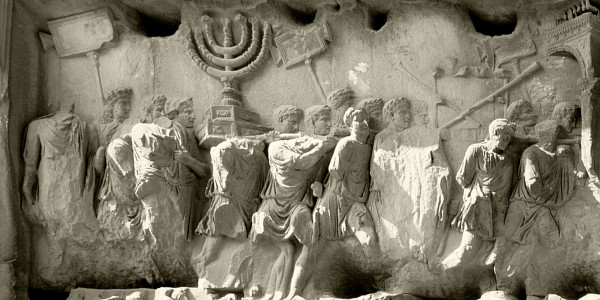
You must be logged in to post a comment.